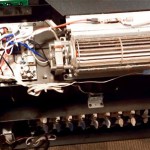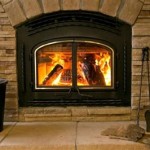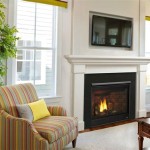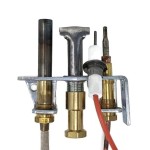Non-Vented Propane Fireplace Inserts: A Comprehensive Guide
Non-vented, also known as vent-free, propane fireplace inserts offer a convenient and efficient solution for adding warmth and ambiance to a room without the need for a traditional chimney or venting system. These inserts utilize propane gas to generate heat, providing a realistic flame appearance and supplemental heating capabilities. Understanding the key features, benefits, safety considerations, and maintenance requirements of non-vented propane fireplace inserts is crucial for making an informed purchasing decision and ensuring safe and effective operation.
A non-vented propane fireplace insert is designed to fit into an existing fireplace opening or a manufactured firebox. Unlike vented fireplaces, which require a flue to exhaust combustion byproducts, non-vented models burn propane gas so completely that they produce minimal emissions. These emissions are generally considered safe within established limits by regulatory agencies. The absence of a vent simplifies installation and offers greater flexibility in placement, as the unit does not need to be located near a chimney. The primary purpose of the insert is to provide supplemental heat to a specific room or area, typically reducing reliance on central heating systems and potentially lowering energy costs.
Numerous factors contribute to the growing popularity of non-vented propane fireplace inserts. The ease of installation is a significant advantage, especially in homes where installing a traditional chimney is impractical or cost-prohibitive. The inserts are also energy-efficient, converting a high percentage of propane gas into usable heat. Because the heat is not lost through a vent, non-vented models can be more efficient than their vented counterparts. Moreover, the aesthetic appeal of a realistic flame enhances the ambiance of a room, creating a cozy and inviting atmosphere.
Key Point 1: Advantages and Benefits of Non-Vented Propane Fireplace Inserts
The advantages of choosing a non-vented propane fireplace insert extend beyond simple installation and energy efficiency. These units offer a range of benefits that make them an attractive option for homeowners seeking supplemental heating and aesthetic enhancement.
Ease of Installation: As previously mentioned, the absence of venting requirements simplifies the installation process considerably. A qualified technician can typically install a non-vented insert in a fraction of the time required for a vented model. This reduced installation time translates to lower labor costs and minimal disruption to the home.
Energy Efficiency: Non-vented propane fireplace inserts are designed to maximize heat output. Because no heat is lost through a vent, these units can achieve efficiency ratings of 99% or higher. This means that nearly all of the propane gas burned is converted into usable heat, reducing energy consumption and lowering heating bills. This makes them an effective option for zone heating, allowing homeowners to heat only the rooms they are using, rather than heating the entire house.
Aesthetic Appeal: Modern non-vented propane fireplace inserts are designed to replicate the appearance of a traditional wood-burning fireplace. Realistic flame patterns, glowing embers, and decorative logs create a visually appealing focal point in any room. These inserts are available in a variety of styles and finishes to complement different décor preferences, from traditional to contemporary.
Convenience: Operating a non-vented propane fireplace insert is incredibly convenient. Most models feature electronic ignition systems and thermostat controls, allowing users to easily adjust the heat output and maintain a consistent room temperature. Some inserts also include remote controls for added convenience, allowing users to operate the fireplace from anywhere in the room.
Supplemental Heating: Non-vented propane fireplace inserts are ideal for providing supplemental heat to a specific room or area. They can effectively warm a room quickly and efficiently, reducing the need to rely on central heating systems and potentially lowering energy costs. This is particularly beneficial during transitional seasons when heating the entire house is not necessary.
Key Point 2: Safety Considerations and Operational Guidelines
While non-vented propane fireplace inserts offer numerous benefits, it is crucial to prioritize safety and adhere to operational guidelines to ensure safe and reliable performance. Understanding the potential risks and implementing preventative measures is essential for protecting occupants and property.
Carbon Monoxide Detection: All non-vented propane fireplace inserts are equipped with Oxygen Depletion Sensors (ODS). This crucial safety feature automatically shuts off the gas supply if the oxygen level in the room drops to a potentially dangerous level, which can indicate a buildup of carbon monoxide. It is imperative to have functioning carbon monoxide detectors installed in the vicinity of the fireplace insert as a redundant safety measure. These detectors provide an audible alarm if carbon monoxide levels exceed safe thresholds.
Proper Ventilation: Although non-vented fireplaces do not require a traditional vent, adequate ventilation is still essential. The manufacturer's instructions should specify the minimum room size and any ventilation requirements, such as leaving a door open or cracking a window. Proper ventilation helps to ensure that oxygen levels remain adequate and that any combustion byproducts are safely dispersed.
Professional Installation: It is strongly recommended to have a qualified technician install a non-vented propane fireplace insert. A professional installer can ensure that the unit is properly connected to the propane supply, that all safety features are functioning correctly, and that the installation complies with local codes and regulations. Self-installation can void warranties and potentially create safety hazards.
Regular Maintenance: Regular maintenance is crucial for ensuring the safe and efficient operation of a non-vented propane fireplace insert. This includes cleaning the burner assembly, checking the ODS sensor, and inspecting the gas connections. Refer to the manufacturer's instructions for specific maintenance recommendations. It is generally advisable to have a professional inspect the unit annually.
Proper Usage: Adhering to the manufacturer's instructions regarding usage is paramount. Avoid using the fireplace for prolonged periods without adequate ventilation. Never use the fireplace as a primary heating source, and never leave it unattended while in operation. Keep combustible materials away from the fireplace, and never place anything on top of it. Children and pets should be supervised around the fireplace to prevent accidental contact with hot surfaces.
Key Point 3: Selecting the Right Non-Vented Propane Fireplace Insert
Choosing the appropriate non-vented propane fireplace insert requires careful consideration of several factors, including heating capacity, aesthetics, features, and budget. Evaluating these criteria will help ensure that the selected insert meets the specific needs and preferences of the homeowner.
Heating Capacity: The heating capacity of a fireplace insert is measured in British Thermal Units (BTUs). The appropriate BTU rating will depend on the size of the room or area that needs to be heated. Consult with a heating professional or refer to BTU calculators to determine the appropriate heating capacity for the specific space. Selecting an insert with too low of a BTU rating will result in inadequate heating, while selecting one with too high of a BTU rating may lead to excessive heat and discomfort.
Aesthetic Considerations: Non-vented propane fireplace inserts are available in a wide range of styles and finishes. Consider the existing décor of the room and select an insert that complements the overall aesthetic. Options include traditional inserts with realistic log sets, contemporary inserts with sleek designs, and models with various flame patterns and ember bed effects. The choice of finish, such as black, brown, or stainless steel, should also align with the room's color scheme.
Features and Controls: Various features and controls can enhance the convenience and functionality of a non-vented propane fireplace insert. Look for features such as electronic ignition, thermostat controls, remote controls, and variable flame height settings. Some inserts also offer programmable timers and safety shut-off features. Evaluate the available features and select those that best meet individual needs and preferences.
Safety Certifications: Ensure that the selected non-vented propane fireplace insert is certified by a reputable testing agency, such as the Canadian Standards Association (CSA) or Underwriters Laboratories (UL). Certification indicates that the unit has been tested and meets established safety standards. Verification of the certification label on the unit itself is important.
Budget and Warranty: Establish a budget for the fireplace insert and explore options within that price range. Consider the long-term cost of ownership, including propane consumption and maintenance expenses. Also, review the warranty offered by the manufacturer. A comprehensive warranty provides protection against defects and malfunctions, offering peace of mind and potential cost savings in the event of repairs.
In conclusion, non-vented propane fireplace inserts offer a versatile and efficient solution for adding warmth and ambiance to a home. By understanding the key features, benefits, safety considerations, and selection criteria, homeowners can make an informed decision and enjoy the comfort and aesthetic appeal of a propane fireplace without the need for a traditional venting system. Ensuring proper installation, maintenance, and adherence to safety guidelines is crucial for safe and reliable operation.

Vent Free Inserts White Mountain Hearth
:max_bytes(150000):strip_icc()/ventless-gas-fireplaces-4160746-hero-f9d4bdcd9bd446eb84406de306f790ba.jpg?strip=all)
How To Pick Out A Ventless Gas Fireplace

Duluth Forge 27 In W 26000 Btu Black Vent Free Dual Burner Gas Fireplace Insert The Inserts Department At Com

Duluth Forge 41 75 In Black Ventless Natural Or Liquid Propane Gas Fireplace The Fireplaces Department At Com

White Mountain Hearth By Empire Ventless Outdoor Traditional Premium Gas Fireplace 36

Modern Free Standing Ventless Gas Fireplace Insert 26 000 Btu

Considering A Ventless Gas Fireplace Here S What You Need To Know Bob Vila

Pleasant Hearth Part Phzc32c Universal Circulating Zero Clearance 32 In Ventless Dual Fuel Fireplace Insert Gas Burning Stove Home Depot Pro

Vent Free Inserts White Mountain Hearth

Considering A Ventless Gas Fireplace Here S What You Need To Know Bob Vila








